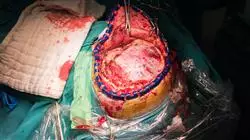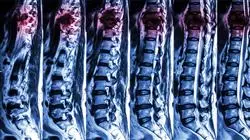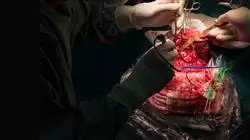University certificate
The world's largest faculty of medicine”
Introduction to the Program
Enhance your expertise in Neurosurgery with a fully online program that covers everything from advanced surgical techniques to Neuro-Oncology, Vascular Surgery, and Spinal Surgery”

Neurosurgery is one of the most demanding and continuously evolving medical specialties. The development of new technologies such as Robot-Assisted Surgery, Neuronavigation, and Artificial Intelligence applied to Diagnosis has transformed the approach to Complex Neurological Pathologies. However, to fully leverage these advances, specialists require continuing education that enables them to integrate the latest knowledge into their daily practice. This academic program addresses that need by providing access to cutting-edge information in Neurosurgery, ensuring rigorous and applicable learning.
The program in Neurosurgery is designed to offer an in-depth understanding of the most advanced surgical techniques, ranging from spinal surgery to the treatment of brain tumors and functional disorders. Thanks to its practical, evidence-based approach, students will acquire key tools for decision-making in highly complex clinical scenarios. Moreover, specializing in this field not only broadens professional opportunities but also allows for more precise and safer patient care, significantly improving surgical outcomes.
One of the program’s greatest advantages is its fully online format, which allows physicians to specialize without interrupting their professional activities. Through an intuitive virtual campus featuring video lectures, interactive materials, and clinical case analyses, graduates can progress at their own pace, optimizing their study time. This modality facilitates access to updated knowledge without the need for travel, adapting to the demands of a medical schedule.
TECH has developed an innovative degree that responds to the current needs of Neurosurgery, combining academic excellence with the flexibility of the digital environment. A university program designed to advance the careers of specialists in a field where constant updating is essential.
Master the most advanced techniques in spinal surgery with a 100% online program. Learn to address degenerative, traumatic and tumor pathologies with the latest advances”
This Master's Degree in Neurosurgery contains the most complete and up-to-date university program on the market. Its most notable features are:
- The development of practical case studies presented by experts in Medicine
- The graphic, schematic, and practical contents with which they are created, provide scientific and practical information on the disciplines that are essential for professional practice
- Practical exercises where the self-assessment process can be carried out to improve learning
- Special emphasis on innovative methodologies in Medicine
- Theoretical lessons, questions to the expert, debate forums on controversial topics, and individual reflection assignments
- Content that is accessible from any fixed or portable device with an Internet connection
Become skilled in the management of aneurysms, arteriovenous malformations and cerebrovascular accidents with an updated approach in microsurgical techniques”
The teaching staff includes professionals belonging to the field of medicine, who contribute their work experience to this program, as well as renowned specialists from reference societies and prestigious universities.
The multimedia content, developed with the latest educational technology, will provide the professional with situated and contextual learning, i.e., a simulated environment that will provide an immersive learning experience designed to prepare for real-life situations.
ience designed to train for real-life situations.
This program is designed around Problem-Based Learning, whereby the student must try to solve the different professional practice situations that arise throughout the program. For this purpose, the professional will be assisted by an innovative interactive video system created by renowned and experienced experts.
Specialize in the latest surgical techniques for the treatment of refractory epilepsy, Parkinson's disease and movement disorders”

Delve into image-guided surgery, minimally invasive approaches and advances in neuro-oncology to optimize outcomes”
Syllabus
Neurosurgery requires up-to-date and specialized knowledge to accurately address complex pathologies. This syllabus combines theory, scientific evidence, and practical application, delving into minimally invasive surgery, advanced neuroimaging, and innovative surgical techniques. It also covers the treatment of brain tumors, vascular diseases, trauma and functional disorders. Thanks to its 100% online modality, it allows access to updated content, video classes and real clinical cases without interrupting professional activity. An academic structure designed to enhance professional development and improve surgical precision in a field where constant updating is key.

Acquire the key competencies for the diagnosis and surgical management of traumatic injuries of the Central Nervous System”
Module 1. General Concepts in Neurosurgery. Intracranial Infectious Disease
1.1. Neurosurgical Patient Positioning
1.2. Neuroanesthesia
1.3. Neurophysiological Monitoring in Neurosurgery
1.4. Neurosurgical Patient Intensive Care
1.4.1. Anti-Seizure Prophylaxis for Neurosurgical Patients
1.5. Brain Localization System. Stereotaxy
1.6. Brain Localization System. Neuronavigation
1.7. Application of Robotics in Neurosurgery
1.8. Cost-Effectiveness in Neurosurgery
1.9. Postoperative Infections in Neurosurgery
1.10. Preventing Infection in Neurosurgical Procedures
1.11. Cerebral Abscesses. Diagnosis and Treatment
Module 2. Traumatic Brain Injury. Peripheral Nerve Pathology
2.1. TBI Classification
2.1.1. Mild TBI Evaluation
2.2. Neuromonitoring
2.3. Treatment of Intracranial Hypertension in Patients with TBI
2.4. Indications for Surgery in Cerebral Contusions and Post-Traumatic Cerebral Edema
2.5. Acute Epidural Hematoma
2.5.1. Cranial Fractures
2.6. Post-Traumatic Subdural Hemorrhage
2.6.1. Acute Subdural Hematoma
2.6.2. Chronic Subdural Hematoma
2.7. TBI in Anticoagulated Patients
2.8. Traumatic Brain Injury in Children
2.9. Peripheral Nerve Pathology. Brachial Plexus Injuries
2.10. Peripheral Nerve Pathology. Peripheral Nerve Entrapment Syndromes
Module 3. Vascular Pathology I. Subarachnoid Hemorrhage and Intracranial Aneurysmal Disease
3.1. Subarachnoid Hemorrhage: Clinical, Diagnostic, and Neurological Prognosis
3.2. Subarachnoid Hemorrhage Complications
3.3. Treating and Managing Patients with Subarachnoid Hemorrhage
3.4. Non-Aneurysmal Subarachnoid Hemorrhage
3.5. Anterior Circulation Aneurysms
3.6. Posterior Circulation Aneurysms
3.7. Natural History and Treatment of Unruptured Brain Aneurysm
3.8. Surgical Treatment of Intracranial Aneurysms
3.9. Endovascular Treatment of Intracranial Aneurysms
3.10. Mycotic and Traumatic Aneurysms
Module 4. Vascular Pathology II. Vascular Malformations and Neurosurgical Stroke Treatment
4.1. Arteriovenous Malformations: Clinical Features, Natural History, and Classification
4.2. Therapeutic Approaches in the Treatment of Arteriovenous Malformations
4.2.1. Surgery
4.2.2. Radiosurgery
4.2.3. Endovascular Treatment
4.3. Cavernomatous Malformations
4.4. Venous Angiomas and Telangiectasias
4.5. Classification and Management of Intracranial Dural Arteriovenous Fistulas
4.6. Spinal Dural Arteriovenous Fistulas Classifications and Treatment
4.7. Carotid-Cavernous Fistulas
4.7.1. Treatment Options in Carotid-Cavernous Fistulas
4.8. Surgical Indication for Hemorrhagic
4.9. Current Status of Neurosurgical Treatment in Ischemic Stroke
4.9.1. Indications for Decompressive Craniectomy in Ischemic Stroke
Module 5. Tumor Pathology I
5.1. Histological and Molecular Classification of Gliomas
5.2. Low-Grade Gliomas
5.3. High-Grade Gliomas
5.4. Therapeutic Algorithm in the Treatment of Gliomas
5.5. Advances in the Surgical Treatment of Gliomas
5.5.1. Fluorescence-Guided Surgery
5.5.2. Surgery in Eloquent Areas
5.6. The Role of Radiotherapy in the Treatment of Gliomas
5.7. Advances in Chemotherapy Treatment of Gliomas
5.8. Ependymal Tumors
5.9. Neuronal Tumors
Module 6. Tumor Pathology II
6.1. Cerebral Metastases
6.1.1. Surgical Treatment Indications
6.1.2. The Role of Radiotherapy in the Treatment of Cerebral Metastases
6.2. Cerebral Meningiomas. Classification and Treatment
6.3. Acoustic Neuroma and Other Pontocerebellar Angle Tumors
6.4. Posterior Fossa Tumors in Adults
6.4.1. Hemangioblastoma
6.4.2. Medulloblastoma in Adults
6.5. Pituitary Adenomas
6.5.1. Indication of Medical and Surgical Treatment
6.6. Craniopharyngiomas and Sellar and Suprasellar Tumors
6.7. Endoscopic Approaches to the Base of the Skull
6.8. Intraventricular Tumors
6.8.1. Surgical Approaches to Intraventricular Tumors
6.9. Pineal Region Tumors: Diagnosis and Treatment Strategy
6.10. CNS Lymphoma
Module 7. Functional Neurosurgery
7.1. Surgical Indications in Epileptic Patients
7.1.1. Pre-Surgery Evaluation
7.2. Surgical Treatments in Epilepsy Surgery
7.2.1. Resective Treatments
7.2.2. Palliative Treatment
7.3. Temporal Epilepsy: Surgical Treatment and Prognosis
7.4. Extratemporal Epilepsy: Surgical Treatment and Prognosis
7.5. Indication for Movement Disorder Surgery
7.6. Deep Brain Stimulation
7.6.1. Surgical Technique
7.7. Historical Progression of Injury in Movement Disorder Surgery
7.7.1. Ultrasound Lesion Application
7.8. Psychosurgery. Indications for Surgical Treatment in Psychiatric Patients
7.9. Neurosurgical Procedures in the Treatment of Pain and Spasticity
7.10. Trigeminal Neuralgia
7.10.1. Percutaneous Techniques
7.10.2. Microvascular Decompression
Module 8. Pediatric Neurosurgery and Cerebrospinal Fluid (CSF) Pathology
8.1. Congenital Brain Malformations
8.1.1. Chiari Malformation
8.2. Open Spina Bifida. Myelomeningocele
8.3. Closed Spinal Dysraphysms
8.4. Simple Craniosynostosis
8.4.1. Positional Skull Deformity
8.5. Syndromic Craniosynostosis
8.6. Vascular Pathology in Children
8.7. Supratentorial Tumors in Pediatric Patients
8.8. Infratentorial Tumors in Pediatric Patients
8.9. Hydrocephalus. Diagnosis and Classification
8.9.1. Posthemorrhagic Hydrocephalus of Prematurity
8.9.2. Chronic Adult Hydrocephalus
8.10. Hydrocephalus Treatment
Module 9. Spinal Pathology. Degenerative Spine
9.1. Lumbar Degenerative Disc Disease
9.2. Surgical Indication in Lumbar Disc Herniation and Lumbar Spinal Stenosis
9.3. Classification and Treatment of Lumbar Spondylolisthesis
9.4. Indications for Lumbar Fusion in Lumbar Degenerative Pathology
9.5. Lumbar Fusion Surgical Techniques
9.6. Principles of Sagittal Balance and Application to Spine Surgery
9.7. Application of Minimally Invasive Surgery in Lumbar Pathology
9.8. Herniated Cervical Disc. Surgical Techniques
9.9. Cervical Canal Stenosis and Cervical Myelopathy
9.9.1. Criteria for Choosing the Surgical Approach
9.10. Herniated Thoracic Disc
9.10.1. Surgical Techniques in the Treatment of Herniated Thoracic Disc
Module 10. Spinal Pathology. Tumor, Fracture, and Infection
10.1. Evaluation of Patients with Post-Traumatic Spinal Cord Injury
10.2. Treatment of Patients with Post-Traumatic Spinal Cord Injury
10.3. Atlas and Axis Fractures
10.4. Classifications and Treatment Indications for Subaxial Cervical Fractures
10.5. Classifications and Surgical Indications for Dorso-Lumbar Fractures
10.6. Primary Spinal Tumors
10.7. Metastatic Spinal Tumors
10.8. Extramedullary Intradural Spinal Tumors
10.9. Intramedullary Spinal Tumors
10.10. Infectious Spondylodiscitis
10.10.1. Surgical Treatment Indications
10.10.2. Postoperative Discitis

Specialize in the surgical approach to Congenital Malformations, Hydrocephalus, Brain Tumors and Refractory Epilepsy in children”
Master's Degree in Neurosurgery
Over the years, the medical field has evolved and today it encompasses different branches, among them, neurosurgery, a science used to treat diseases affecting the central and peripheral nervous system. This in turn is complemented by neurology, oncology, psychiatry, otolaryngology and orthopedic and maxillofacial surgery. To meet the academic needs and help boost the careers of physicians who wish to specialize in this sector; at TECH we developed a Master's Degree in Neurosurgery. An online program of high academic level focused on knowing the latest surgical techniques necessary to perform as a neurosurgeon. You will specialize in expanding all the knowledge related to this field; in addition, you will have within reach the latest diagnostic and therapeutic guidelines based on the most updated scientific evidence. This will allow them to learn all about the general concepts in neurosurgery, which covers the treatment of various pathologies such as cranioencephalic trauma, subarachnoid hemorrhage and intracranial infection.
Earn a Master's Degree from the world's largest School of Medicine
During 1,500 hours you will be prepared with the best tools and techniques to perfect the practice of your profession. At TECH you will find the most advanced educational technology on the market, since the content and methodology of this curriculum has been designed by a team of professionals dedicated to the medical sector. This makes it easy to take your program with the most optimal theoretical and practical methods. You will learn in depth the technological innovations that have contributed to the diagnostic and therapeutic advances in neurosurgery, designed with the objective of improving the quality of care for patients. Because of this, you will delve into the treatment of problems such as vascular malformations, the neurosurgical procedure of stroke and spinal pathology, tumors and degenerative spine.
Specialize in neurosurgery
All physicians who wish to revalue their professional profile and improve their skills will find in TECH the ideal option to boost their career growth. We have unique online teaching methods in the market that will allow them to develop the degree in a completely autonomous way. They will have the necessary basis to become experts in diagnosing and treating neurosurgical pathology in a completely new way. In addition, you will be able to participate in discussion forums to exchange ideas and/or study approaches.







